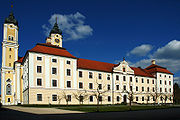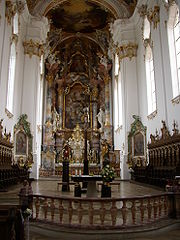
Roggenburg Abbey
Encyclopedia
Roggenburg Abbey is a Premonstratensian
canonry in Roggenburg
near Neu-Ulm
, Bavaria
, in operation between 1126 and 1802, and again from its re-foundation in 1986. Since 1992 it has been an independent priory of Windberg Abbey
in Lower Bavaria
(Roggenburg Priory). The monastery manages a training centre and a museum, and is widely known for its almost unchanged Baroque
building and the organ concerts that are held in the church.


 In 1126 Count Bertold of Bibereck, together with his wife and his two brothers, Konrad, Bishop of Chur
In 1126 Count Bertold of Bibereck, together with his wife and his two brothers, Konrad, Bishop of Chur
, and Siegfried, a canon
in the diocese of Augsburg, founded the monastery. The first Premonstratensian canons came from Ursberg Abbey
nearby and built the first monastery church.
In 1444 the foundation was raised to the status of an abbey. The first description of Roggenburg Abbey as reichsunmittelbar dates from 1482/5; the legal consolidation of this status took place in tiny stages over the first half of the 16th century.
In the 18th century the abbey and its dependent churches were rebuilt in the Baroque
style, as they are today. The conventual buildings were rebuilt in 1732. Construction of a new church began in 1752, and lasted six years.
In 1802 the monastery was occupied by Bavarian troops during the secularisation
of Bavaria, dissolved, and the last abbot, Thaddäus Aigler, stripped of his office.
. In the interval there had arisen a training centre for family, environment and culture, a museum and a centre for art and culture, as well as gastronomical facilities. In addition, the monastery shop sells devotional items, the monastery's own wine and various other products of their own manufacture.
, with extended transept and double towers, is 70 metres long, 35 metres across and has an inside height, to the highest point, of 28 metres. Today it is used as the Roman Catholic parish church of the Ascension of the Virgin Mary]].
by the Ulm
organ builder Georg Friedrich Schmahl of 1761 was completely replaced in 1905 by a Late Romantic construction by the Gebrüder Hindelang of Ebenhofen. This was replaced in its turn in 1955–56, with the reuse of some registers, by an instrument by the Familie Nenninger. In 1984–86 it was extensively rebuilt by Gerhard Schmid of Kaufbeuren
. The appearance of the organ by Schmahl was preserved throughout all rebuildings.
Premonstratensian
The Order of Canons Regular of Prémontré, also known as the Premonstratensians, the Norbertines, or in Britain and Ireland as the White Canons , are a Catholic religious order of canons regular founded at Prémontré near Laon in 1120 by Saint Norbert, who later became Archbishop of Magdeburg...
canonry in Roggenburg
Roggenburg, Germany
Roggenburg is a municipality in the district of Neu-Ulm in Bavaria in Germany.Roggenburg is known for the Roggenburg Abbey, which is used today by the Premonstratensians...
near Neu-Ulm
Neu-Ulm
Neu-Ulm is a town in Bavaria, capital of the Neu-Ulm district. Neighbouring towns include Ulm, Senden, Pfaffenhofen an der Roth, Holzheim, Nersingen and Elchingen. The population is 51,110 .-History:...
, Bavaria
Bavaria
Bavaria, formally the Free State of Bavaria is a state of Germany, located in the southeast of Germany. With an area of , it is the largest state by area, forming almost 20% of the total land area of Germany...
, in operation between 1126 and 1802, and again from its re-foundation in 1986. Since 1992 it has been an independent priory of Windberg Abbey
Windberg Abbey
Windberg Abbey is a Premonstratensian monastery in Windberg in Lower Bavaria, Germany.-First foundation:Windberg Abbey was founded by Count Albert I of Bogen with the assistance of Bishop Otto of Bamberg on the site of the original seat of the Counts of Bogen...
in Lower Bavaria
Lower Bavaria
Lower Bavaria is one of the seven administrative regions of Bavaria, Germany, located in the east of the state.- Geography :Lower Bavaria is subdivided into two regions - Landshut and Donau-Wald. Recent election results mark it as the most conservative part of Germany, generally giving huge...
(Roggenburg Priory). The monastery manages a training centre and a museum, and is widely known for its almost unchanged Baroque
Baroque architecture
Baroque architecture is a term used to describe the building style of the Baroque era, begun in late sixteenth century Italy, that took the Roman vocabulary of Renaissance architecture and used it in a new rhetorical and theatrical fashion, often to express the triumph of the Catholic Church and...
building and the organ concerts that are held in the church.
First foundation



Bishop of Chur
The Bishop of Chur is the Ordinary of the Roman Catholic Diocese of Chur, Grisons, Switzerland .-History:...
, and Siegfried, a canon
Canon (priest)
A canon is a priest or minister who is a member of certain bodies of the Christian clergy subject to an ecclesiastical rule ....
in the diocese of Augsburg, founded the monastery. The first Premonstratensian canons came from Ursberg Abbey
Ursberg Abbey
Ursberg Abbey is a former Premonstratensian monastery, now a convent of the Franciscan St. Joseph's Congregation, situated in the small village of Ursberg in the district of Günzburg, Bavaria.-History:...
nearby and built the first monastery church.
In 1444 the foundation was raised to the status of an abbey. The first description of Roggenburg Abbey as reichsunmittelbar dates from 1482/5; the legal consolidation of this status took place in tiny stages over the first half of the 16th century.
In the 18th century the abbey and its dependent churches were rebuilt in the Baroque
Baroque architecture
Baroque architecture is a term used to describe the building style of the Baroque era, begun in late sixteenth century Italy, that took the Roman vocabulary of Renaissance architecture and used it in a new rhetorical and theatrical fashion, often to express the triumph of the Catholic Church and...
style, as they are today. The conventual buildings were rebuilt in 1732. Construction of a new church began in 1752, and lasted six years.
In 1802 the monastery was occupied by Bavarian troops during the secularisation
German Mediatisation
The German Mediatisation was the series of mediatisations and secularisations that occurred in Germany between 1795 and 1814, during the latter part of the era of the French Revolution and then the Napoleonic Era....
of Bavaria, dissolved, and the last abbot, Thaddäus Aigler, stripped of his office.
After dissolution
The abbey church became a parish church. The rest of the abbey's property passed into private ownership, except for the buildings, which were taken over by the Bavarian government. Until 1862 a district court and rent office were accommodated here. Later the buildings were used for a variety of functions, including as a school, a forestry office and a parochial office.Second foundation
In 1986 Premonstratensians again occupied the premises. On 8 November 1992 the new community was raised to the status of an independent priory of Windberg AbbeyWindberg Abbey
Windberg Abbey is a Premonstratensian monastery in Windberg in Lower Bavaria, Germany.-First foundation:Windberg Abbey was founded by Count Albert I of Bogen with the assistance of Bishop Otto of Bamberg on the site of the original seat of the Counts of Bogen...
. In the interval there had arisen a training centre for family, environment and culture, a museum and a centre for art and culture, as well as gastronomical facilities. In addition, the monastery shop sells devotional items, the monastery's own wine and various other products of their own manufacture.
Abbey church
The Baroque abbey church was built between 1752 and 1758 to plans by Simpert Kraemer in the shape of a cross. The hall churchHall church
A hall church is a church with nave and side aisles of approximately equal height, often united under a single immense roof. The term was first coined in the mid-19th century by the pioneering German art historian Wilhelm Lübke....
, with extended transept and double towers, is 70 metres long, 35 metres across and has an inside height, to the highest point, of 28 metres. Today it is used as the Roman Catholic parish church of the Ascension of the Virgin Mary]].
Organ
The great Baroque organOrgan (music)
The organ , is a keyboard instrument of one or more divisions, each played with its own keyboard operated either with the hands or with the feet. The organ is a relatively old musical instrument in the Western musical tradition, dating from the time of Ctesibius of Alexandria who is credited with...
by the Ulm
Ulm
Ulm is a city in the federal German state of Baden-Württemberg, situated on the River Danube. The city, whose population is estimated at 120,000 , forms an urban district of its own and is the administrative seat of the Alb-Donau district. Ulm, founded around 850, is rich in history and...
organ builder Georg Friedrich Schmahl of 1761 was completely replaced in 1905 by a Late Romantic construction by the Gebrüder Hindelang of Ebenhofen. This was replaced in its turn in 1955–56, with the reuse of some registers, by an instrument by the Familie Nenninger. In 1984–86 it was extensively rebuilt by Gerhard Schmid of Kaufbeuren
Kaufbeuren
Kaufbeuren is an independent city in the Regierungsbezirk of Schwaben, southern Bavaria. The city is completely enclaved within the district of Ostallgäu.- Culture and Objects of Interest :* Townhall * Crescentiakloster...
. The appearance of the organ by Schmahl was preserved throughout all rebuildings.

